The Current View
A lengthy downtrend in sector prices had given way to a relatively stable trajectory after mid 2013 similar to that experienced in the latter part of the 1990s and first few years of the 2000s.
The late 1990s and early 2000s was a period of macroeconomic upheaval during which time sector pricing nonetheless proved relatively stable.
Relative stability suggests a chance for companies genuinely adding value through development success to see their share prices move higher. This was the experience in the late 1990s and early 2000s.
Still vulnerable cyclical conditions were aggravated in the second half of 2015 by a push from investors worldwide to reduce risk. Sector prices were pushed to a new cyclical low. These conditions were reversed through 2016 and 2017 although sector prices have done little more than revert to the 2013 levels which had once been regarded as cyclically weak.
With a median decline in prices of ASX-listed resources companies through the cycle of 89%(and 30% of companies suffering a decline of more then 95%), the majority of stocks remain prone to strong 'bottom of the cycle' leverage in response to even slight improvements in conditions.
Has Anything Changed?
The strength of the US dollar exchange rate since mid 2014 had added an unusual weight to US dollar prices. Reversal of some of the currency gains has been adding to commodity price strength through 2017.
Signs of cyclical stabilisation in sector equity prices has meant some very strong ‘bottom of the cycle’ gains.
Funding for project development has passed its most difficult phase with the appearance of a stronger risk appetite.

Resource Sector Weekly Returns

Market Breadth Statistics

52 Week Price Ranges

Equity Markets




Markets were jolted late in the week by Facebook which reported lowere earnings than analysts had been expecting as a result of having to deal with demands for improved privacy protections. The Facebook predicament led immediately to questions about the sustainability of earnings among other social media companies.
One of the outcomes of the Facebook market reaction has been a move to differentiate between varying business models when assessing the market values of technology oriented companies. Such a change in attitude is beneficial insofar as it prevents the herding which eventually requires more dramatic share price adjustments.
S&P 500 financial and energy sectors moved ahead despite the damage to the technology sector.
Trade policy uncertainty continued to dog markets with increasing numbers of US businesses objecting to the negative impact of the Trump approach to Chinese trade practices.
Smaller stocks within the US market lost ground despite the US government reporting that GDP growth in the second quarter of 2018 was stronger than in any quarter since 2014.
Donald Trump appears willing to use the strength of the economy as cover for his attacks on Chinese trade. Markets appear unperturbed by these tactics seemingly prepared to assume that short term negotiating ploys will result in favourable outcomes without serious dislocation.
The newly elected Mexican leader has flagged a willingness for a quick NAFTA deal or a specific trade agreement between the USA and Mexico, ameliorating some of the trade tensions within North America.
In the UK, the government's slimmed down Brexit ambitions outlined in a White Paper received a lukewarm response from European bureaucrats with Prime Minister May flagging that she would deal directly with national leaders to achieve an agreement.
The lack of progress toward an agreement with the EU as the deadline to leave approaches appears to be having a negative effect on economic growth with official preparations for 'no deal' now adding to anxieties.
Resource Sector Equities



Material sector prices remain within their uptrend while hovering near the lower bound of the range. Stocks appear to be tracking equity market conditions more closely than the prices of industrial raw materials.
Leading miners have faced headwinds associated with the threats to global trade disruption and, more broadly, from revisions to global growth prospects arising from non trade factors such as low productivity growth.
Sector momentum is less strong than it had been two or three months ago but equity prices showed surprising resilience in the past week with solid gains among both market leaders and the smallest exploration stocks in the sector.
Smaller stocks again performed better than the larger stocks in the sector as asset allocation decisions amongst larger investors focused on the latter group of companies. Smaller stocks would have benefitted from the commencement of the new financial year.
In the Australian context, industrial stocks have made gains against resources stocks over the past two months and continued their uptrend in the past week..
Interest Rates
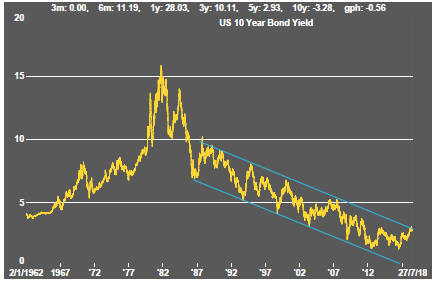
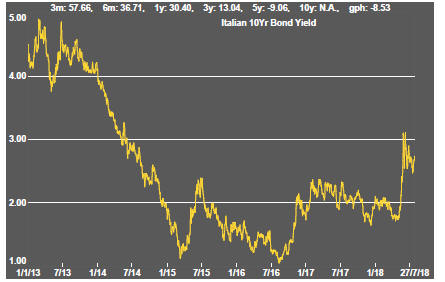

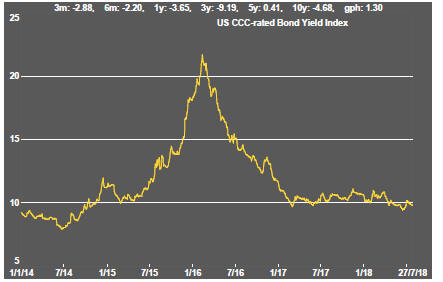
Financial market conditions have stabilised with a strong consensus in the USA, Europe and Japan about the direction of monetary policy in the year ahead.
The latest US GDP growth report was consistent with the improved conditions spoken about by the Federal Reserve chairman Jerome Powell a week earlier. Consumer demand has been strengthening although personal income growth remains subdued and inflation measures did not point to risks of interest rates being pushed up more quickly than currently expected.
Near term monetary conditions are largely supportive of the resources sector although that support will erode over time as the move to more normal interest rates occurs in the USA, Japan and Europe.
Corporate debt funding costs remain anchored near cyclical low levels.
Exchange Rates








Upward pressure on the US dollar has diminished as the tug of war between the US and Europe has been inconclusive.
EU leader Junker's visit to Washington in the past week appeared to produce an easing of tensions between the two parties as they agreed to talk about broad based tariff reductions.
Sterling has been weakening in response to a succession of threats to the leadership of Prime Minister May and doubts about her ability to gain parliamentary agreement for her revamped European exit plans (and then persuade the European leaders of the merit of her proposals).
The most conspicuous move has once again come from the yuan, A move lower by the Chinese currency will give export oriented Chinese companies some breathing space against pressures from a tariff battle with the US government and may convey a warning to the US about how China might react to further tariff based measures by the USA.
Currencies are at risk of being dragged into the war of words on trade with a possibly rising US dollar acting as a drag on corporate competiveness even as the US administration is attempting to boost global sales.
Developing country exchange rates continued to brace for further weakness although the downward momentum has diminished.
Initially individual differences in the causes of currency weakness had merged into a theme into which the Australian dollar has been pulled. The Australian currency appears to have fallen out of an upward trend which dated from early 2016 as it has become a victim of the potential trade disruptions.
Commodity Prices

The general upswing in commodity prices since mid 2017 had been given added impetus by stronger crude oil prices.
Diminished momentum has left prices within the bounds of a cyclical trough, albeit at the upper end.
The flip side of the benefits for commodity producers and exporters of higher commodity prices is the cost pressure now being experienced by users of agricultural and raw material commodities. Reporting companies have been suggesting this as a source of margin compression.
Business surveys closely watched by central banks are showing signs of upward pressure on selling prices as a result of higher raw material prices.
Gold & Precious Metals
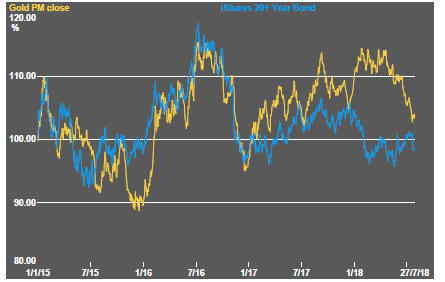


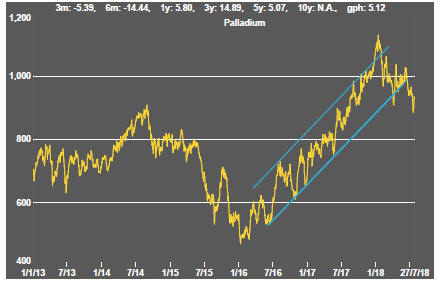


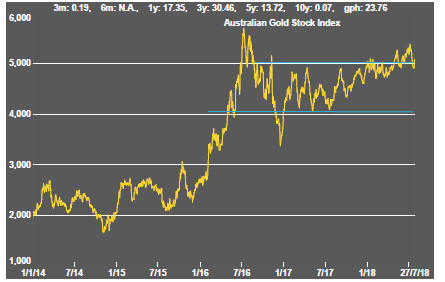
Looked at against broader financial market conditions, gold had appeared overpriced and at risk of a significant reversal. Further bond price falls are likely to aggravate the trend.
Across the precious metal sector, prices have broken through the bounds of prior trading ranges.
Gold and palladium price uptrends have been broken. Platinum prices fell below the lower bound of a two year trading range. Silver prices have proved the most resilient only by falling least.
The divergence in trend between Australian and north American gold related equities had taken a step toward convergence but the gap remains large and suggestive of relative underperformance among the Australian branch of the market.
Nonferrous Metals



Metal prices moved slightly higher at the end of the week but only after a conspicuous loss of momentum and earlier price declines. Some relief from concerns about US trade policy were little more than a respite.
Industry statistics continue to signal that higher prices have been driven by unusually weak demand mitigated by lowered production rates leaving them at risk of reversal as new supplies enter the market in response to price incentives.
Much of the commentary about the decline in copper prices has focused attention on the impact of trade policy. There will have been some effect from this source but prices had shown little net change for the best part of a year amidst a clear loss of momentum before the trade policy issue began to gain traction.
Bulk Commodities
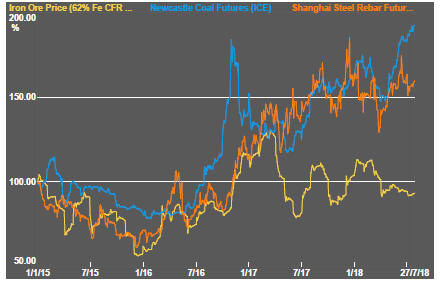
Relatively weak first quarter Chinese GDP growth had suggested a ramp up in activity through the remainder of 2018 if China was going to meet its growth target which, in a centrally controlled economy in which leaders are trying to maintain credibility, is a reasonable assumption.
The difficultly of achieving its targets has now been acknowledged by Chinese officials who have conceded that second half growth may not be as strong as had been expected.
Nonetheless, the Chinese government reported a June quarter GDP growth in line with its stated target.
Coal prices continued to rise with strong demand growth from China where thermal coal volumes grew at their fastest pace since 2011. Indian port authorities have also reported strong growth in coal movements in the second quarter of 2018.
Iron ore prices have failed to reflect the ongoing expansion in Chinese manufacturing output with some concerns of a loss of manufacturing momentum as a result of constraints on Chines exports to the USA.
Oil and Gas


The upward trend in crude oil prices has moderated.
Prices had reached the highest levels in several years before breaking lower after comments from major producers that a production increase might be contemplated and reports of Russian president Vladimir Putin saying that a $60/bbl oil price would be adequate.
The sharp market response to the slightly more bearish tone might have led to some reconsideration of any plans to push output higher.
While a meeting of OPEC members decided to expand production, the size of the increase was less than had been expected.
The push by the US administration to re-impose economic sanctions on Iran is also working to put upward pressure on oil prices to the point that some producers had become concerned about an adverse effect on demand.
The Iranians have been lobbying European countries to prevent more widespread application of sanctions but the likelihood of relief appears slim as long as funds must circulate through US banks.
US production, in any event, continues to rise and is now matching output from Russia and Saudi Arabia. Texas alone is positioned to be the third largest producer after Russia and Saudi Arabia.
Despite the change in tone within crude oil markets, related equity prices have been muted in their responses, implicitly signaling scepticsm about the sustainability of price rises.
Battery Metals


Eighteen months of rising lithium-related stock prices gave way to a period of market reassessment as a lengthy pipeline of potential new projects raised the prospect, although not conclusively, of ongoing supplies being adequate for expected needs.
Potential lithium producers have been able to respond far more quickly to market signals than has been the case in other segments of the mining industry where development prospects have been slowed by reticence among financiers to back development.
Movements in lithium related equity prices have been aligned more closely with overall sector equity prices in recent weeks.

Battery metals remain a focal point for investors with recent attention moving to cobalt and vanadium.
Doubts about a peaceful transfer of political power in the Democratic Republic of the Congo (and an Ebola outbreak) had added a dimension to cobalt prices lacking in other metals caught up in the excitement over transport electrification. Improved political conditions left cobalt prices at risk of some retracement.
In the longer term, cobalt is the most vulnerable of the battery related metals to substitution with high prices likely to stimulate research in that direction.
A spokesperson for Panasonic, manufacturer of batteries for Tesla motor vehicles, has been quoted as saying that the company intends to halve the cobalt content of its batteries because of uncertainties over supply.
Uranium


The uranium sector is in the midst of forming a prolonged cyclical trough as market balances slowly improve. Power utilities are still not prepared to re-enter the market for contracted amounts of metal to meet longer term needs. A slight upward bias in prices has been evident in the past month.
Slightly higher equity prices from time to time, in the hope of improved conditions, have not been sustained but could be repeated as speculation about improved future demand ebbs and flows. In the very near term, an announcement by Canadian producer Cameco to extend the duration its previously implemented production cut has given the market a very slight lift.
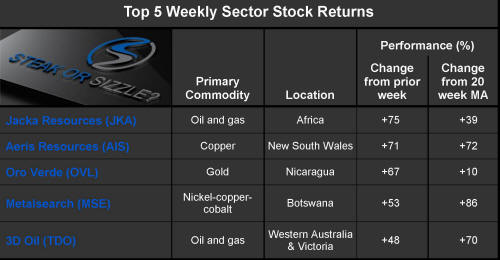
The Steak or Sizzle? blog LINK contains additional commentary on the best performed stocks in the sector and the extent to which their investment outcomes are underpinned by a strong enough value proposition to sustain the gains.

